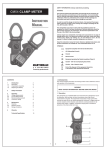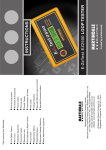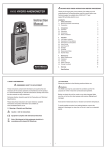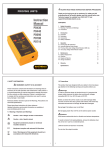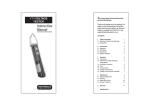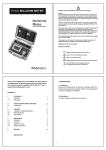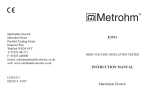Download Manual - Martindale Electric
Transcript
TEK500 MICROWAVE LEAKAGE DETECTOR GENERAL SAFETY INFORMATION: Always read before proceeding. Warning These instructions contain both information and warnings that are necessary for the safe operation and maintenance of this product. It is recommended that you read the instructions carefully and ensure that the contents are fully understood. Failure to understand and to comply with the warnings and instructions can result in serious injury, damage or even death. INSTRUCTION MANUAL In order to avoid the danger of electrical shock, it is important that proper safety measures are taken when working with voltages exceeding 30V AC RMS, 42V AC peak or 60V DC. This product must only be used by a competent person capable of interpreting the results under the conditions and for the purposes for which it has been constructed. Particular attention should be paid to the Warnings, Precautions and Technical Specifications. Always check the unit is in good working order before use and that there are no signs of damage to it. Do not use if damaged. Where applicable other safety measures such as use of protective gloves, goggles etc. should be employed. Please keep these instructions for future reference. Updated instructions and product information are available at: www.martindale-electric.co.uk REMEMBER: SAFETY IS NO ACCIDENT MEANING OF SYMBOLS: Equipment complies with relevant EU Directives Caution - refer to accompanying documents Caution - risk of electric shock End of life disposal of this equipment should be in accordance with relevant Local Directives MARTINDALE ELECTRIC Trusted by Professionals Thank you for buying one of our products. For safety and full understanding of its benefits please read this manual before use. Technical support is available from 01923 441717 and [email protected]. 1. INTRODUCTION 1.1 Inspection Examine the shipping carton for any sign of damage. Inspect the unit and any accessories for damage. If there is any damage then consult your distributor immediately. CONTENTS 1 1.1 1.2 Introduction Inspection Description 1 1 1 2 2.1 Product Specific Safety Information Precautions 3 3 3 3.1 3.2 Operation Installing or Replacing Batteries How it Works 4 4 4 4 4.1 4.2 4.3 4.4 Maintenance Calibration Cleaning Repair & Service Storage Conditions 12 12 12 12 12 5 Warranty 13 1.2 Description To install or replace batteries refer to section 3.1 The TEK500 is a microwave leakage detector with a built-in selftest feature, LED indicators for microwave power and an audible warning device. The unit is designed to test for microwave leakage in accordance with the routine test defined within BS EN 60335-2-25:2002, Safety of household and similar electrical appliances - Domestic microwave ovens, and within BS EN 60335-2-90:2002, Safety of household and similar electrical appliances - Commercial microwave ovens. Further guidance on recommended maximum exposure levels to microwave radiation is contained in NRPB Documents GS15_2 and GS15_3 published in 2004, and in the 1988 Recommendations of the International Non-Ionizing Radiation Committee. The above standards and guidance documents recommend that microwave leakage (expressed as microwave power density in milliWatts per square centimetre) from microwave ovens and similar appliances, should not exceed 5mW/cm2, (which can also be expressed as 50W/m2), when measured at a distance of 50mm or more from the exterior surface of the appliance under test. Specifications 1 The TEK500 indicates microwave power density at values of >1mW/cm2 (Yellow LED), >5mW/cm2 (Red LED) and >10mW/cm2 (Red LED). 2. PRODUCT SPECIFIC SAFETY INFORMATION 2.1 Precautions This product has been designed with your safety in mind, but please pay attention to the following warnings and cautions before use. The conical form at the back of the instrument makes it easy to maintain the prescribed distance of 50mm while the instrument is moved over the exterior surfaces of the appliance under test. Warning Before use check the unit for cracks or any other damage. Make sure the unit is free from dust, grease and moisture. Also check any associated leads and accessories for damage. Do not use if damaged. UNDER NO CIRCUMSTANCES MUST THE TEK500 BE PLACED INSIDE A MICROWAVE OVEN. UNDER NO CIRCUMSTANCES MUST THE THERMOMETER (SUPPLIED) BE PLACED INSIDE A MICROWAVE OVEN. FOR COMBINATION OVENS, WITH RADIANT HEATERS FOR ROAST OR BAKE SETTINGS, DO NOT RUN THE OVEN AT RADIANT HEAT SETTINGS DURING THE TESTS DESCRIBED BELOW: USE MICROWAVE POWER ONLY. MICROWAVES ARE POTENTIALLY DANGEROUS: MICROWAVE APPLIANCES SHOULD NOT BE ADJUSTED OR REPAIRED BY ANYONE EXCEPT PROPERLY QUALIFIED SERVICE PERSONNEL. It is important not to defeat or tamper with safety interlock switches. Before carrying out the leakage test, check that the safety interlock switches on the oven operate effectively, such that the microwave power is cut OFF automatically before the oven door can be opened. 2 3. OPERATION 3 3.2.3 Microwave Oven Leakage Test The following routine test should be carried out on microwave ovens, to ensure that microwave leakage remains below the recommended safe maximum of 5 mW/cm2. 3.1 Installing or Replacing Batteries Remove the battery cover using a screwdriver. Install batteries. The leakage test should be carried out with the microwave oven connected to its rated power source. Replace the battery cover. Half fill the supplied beaker with water and place in the centre of the Microwave oven. 3.2 How it Works 3.2.1 Before Use Before use, the TEK500 microwave leakage detector MUST BE TESTED using the built-in self-test feature. This 'CHECK' function injects a microwave signal into the antenna of the detector to ensure that every stage of the internal circuitry is operating correctly. Slide the switch to the 'CHECK' position and check that the ‘ON' and the three power indicator LEDs are illuminated (for 1, 5 and 10mW/cm2 respectively) and that the audible tone is present. If any of the four indicators fails to illuminate, replace the battery and retest the unit. If the unit will not illuminate all four indicators simultaneously and operate the audible tone correctly during selftest, DO NOT USE IT, but instead return it to Martindale Electric for investigation and repair according to the terms of your warranty. 3.2.2 Operation If the self-test results are satisfactory, slide the switch to the 'DETECT' position and check that the power indicators extinguish, that the audible tone is de-activated and that the green 'ON' indicator is illuminated. The TEK500 microwave leakage detector is now ready for use. 4 The oven should then be operated at its maximum microwave power setting. FOR COMBINATION OVENS, WITH RADIANT HEATERS FOR ROAST OR BAKE SETTINGS, DO NOT RUN THE OVEN AT RADIANT HEAT SETTINGS: USE Fig. 1 MICROWAVE POWER ONLY. While the microwave oven is running, place the flat tip of the cone against the surface of the appliance (Fig. 1) and move the detector about slowly all over the exterior surface of the oven to locate points of microwave leakage, paying particular attention to the door seal, the edges of the door, the front window, any seams in the case construction and any ventilation slots visible. The yellow LED indicator will signal when microwave power is detected above 1mW/cm2. This is an acceptable level. Hazardous radiation detected above 5mW/cm2 & 10mW/cm2 respectively is indicated by the red LED indicators. An audible tone will sound as an additional warning of microwave leakage that is 5 present above the 5mW/cm2 safety limit. In the event of extended or repeated tests, the water in the beaker should be changed as necessary to prevent boiling and evaporation. ROAST OR BAKE SETTINGS, DO NOT RUN THE OVEN AT RADIANT HEAT SETTINGS: USE MICROWAVE POWER ONLY. (Note, The heating time is not critical, but must be recorded accurately: for an oven with an imprecise clockwork timer, use a stopwatch or wristwatch with a second-hand to establish the duration of the test). An oven that exhibits microwave leakage of 5mW/cm2 as above should be taken out of service and investigated for faults by a competent service engineer. It should not be put back into service until faults are cured and the oven can be shown to pass the microwave leakage test. Immediately after the 90 seconds microwave heating episode, open the door, give the contents of the beaker a very brief stir using the thermometer, then measure the final temperature of the water. 3.2.4 Supplementary Test A procedure to establish the output power of the oven. After the microwave leakage test is found to give a satisfactory result, the following procedure can be used as a simple functional test to assess the microwave heating power of the oven. Determine the rise in temperature from: This functional test should be carried out with the microwave oven connected to its rated power source. The microwave heating power of the oven can be estimated from the following formula: Fill the polypropylene beaker to the 1 litre line with water at room temperature. Use the thermometer (supplied) to measure the initial temperature accurately. Record the actual water volume and the Initial Temperature accurately. Place it in the centre of the lowest shelf in the oven. Microwave Heating Power (Watts) = 4190 X (Temperature Rise) Temperature Rise = (Final Temperature) – (Initial Temperature) Heating Time (seconds) (Note: This formula is simplified for convenience. Result should be rounded down to nearest 50W). DO NOT LEAVE THE THERMOMETER IN THE BEAKER. The oven should then be operated at its maximum microwave power setting for 90 seconds. FOR COMBINATION OVENS, WITH RADIANT HEATERS FOR 6 7 Note that Industrial and Commercial Microwave Ovens fall into a separate category. IMPORTANT INFORMATION It is important that the quantity of water, temperature rise and heating time are all recorded accurately, to reduce any errors. However, our experience shows that many ovens will appear to under-perform. While the TEK500 itself is suitable for testing the level of microwave leakage around door seals etc, the assessment of microwave oven heating performance is beyond the scope of the TEK500 thermometer and beaker Kit. Results may indicate a heating performance as low as 60% of the "declared" performance that has been marked on the oven by the manufacturer. Such Industrial and Commercial Microwave Ovens typically will be physically larger and more powerful than household microwave ovens. A number of factors can contribute to this low reading, some of which will be influenced by the construction and physical size of the oven, as follows: They are covered by a separate standard, which should be consulted if applicable: 1. Container is not large enough in area to pick up the output of the magnetron effectively. 2. Water volume is too low. 3. Error in initial temperature measurement. 4. Error in final temperature measurement. 5. Error in measurement of true heating time, especially on ovens with a clockwork timer. 6. Error in allowance for the magnetron initial heating time. 7. Thermal capacity of the container used during test is not taken into account. 8. Rating declared by manufacturer is permitted to vary by +/15% and may present an optimistic figure. 9. Rating declared by manufacturer may not have been rounded down to nearest 50 Watts. 10. Magnetron has degraded over its working life. Where an oven appears to under-perform when assessed using the simplified formula, the full test procedure can be employed, as given in British & European Standard BS EN 60705:1999/IEC 60705:1999. BS EN 61307_2006 Industrial Microwave Oven Heating Performance. Again, information should be sought from the oven manufacturer if there is any difficulty in assessing the heating performance of such Industrial or Commercial Microwave Ovens. 3.2.5 At the end of all testing, ensure that the TEK500 has been switched OFF, before returning it to its carry case. 8 9 4. MAINTENANCE 5. WARRANTY AND LIMITATION OF LIABILITY 4.1 Calibration To maintain the integrity of measurements made using your instrument, Martindale Electric recommends that it is returned at least once a year to an approved Calibration Laboratory for recalibration and certification. This Martindale product is warranted to be free from defects in material and workmanship under normal use and service. The warranty period is 2 years and begins on the date of receipt by the end user. This warranty extends only to the original buyer or enduser customer, and does not apply to fuses, disposable batteries, test leads or to any product which, in Martindale’s opinion, has been misused, altered, neglected, contaminated, or damaged by accident or abnormal conditions of operation, handling or storage. Martindale Electric is pleased to offer you this service. Please contact our Service Department for details. E: [email protected] T: 01923 650660 Martindale authorised resellers shall extend this warranty on new and unused products to end-user customers only but have no authority to extend a greater or different warranty on behalf of Martindale. 4.2 Cleaning The unit may be cleaned using a soft dry cloth. Do not use moisture, abrasives, solvents, or detergents, which can be conductive. Martindale's warranty obligation is limited, at Martindale's option, to refund of the purchase price, free of charge repair, or replacement of a defective product which is returned to Martindale within the warranty period. 4.3 Repair & Service There are no user serviceable parts in this unit other than those that may be described in section 3. Return to Martindale Electric if faulty. Our service department will quote promptly to repair any fault that occurs outside the guarantee period. This warranty is the buyer’s sole and exclusive remedy and is in lieu of all other warranties, expressed or implied, including but not limited to any implied warranty of merchantability or fitness for a particular purpose. Martindale shall not be liable for any special, indirect, incidental or consequential damages or losses, including Before the unit is returned, please ensure that you have checked the unit and batteries. loss of data, arising from any cause or theory. 4.4 Storage Conditions The instrument should be kept in warm dry conditions away from direct sources of heat or sunlight, and in such a manner as to preserve the working life of the unit. It is strongly advised that the unit is not kept in a tool box where other tools may damage it. 10 Since some jurisdictions do not allow limitation of the term of an implied warranty, or exclusion or limitation of incidental or consequential damages, the limitations and exclusions of this warranty may not apply to every buyer. If any part of any provision of this warranty is held invalid or unenforceable by a court or other decision11 maker of competent jurisdiction, such holding will not affect the validity or enforceability of any other provision or other part of that provision. USER NOTES Nothing in this statement reduces your statutory rights. 12 13 MARTINDALE USER NOTES ELECTRIC Specification TEK500 microwave leakage detector Testing complies with BS EN 60335-2-25:2002 and BS EN 60335-2-90:2002 Supply: 9V alkaline battery, MN1604 or equivalent (included) Frequency of Operation: 2450 ± 25MHz Power Density Range: ±1dB for planewave of all polarisations Cardinal Points: >1mW/cm2, >5mW/cm2, >10mW/cm2 Response to Step Input: 2-3 seconds to reach 90% of steady state indication Overload Capacity: 50mW/cm2 Indicators: LED (green) - Battery OK LED (yellow) - 1mW/cm2 - Acceptable microwave leakage below safety limit LEDs (red) at 5 & 10mW/cm2 and audible tone - Hazardous microwave leakage above safety limit Cone Spacer: Prescribed test distance of 50mm is achieved when cone tip is in contact with appliance Operating Temperature: -5°C to 40°C Case: Yellow FR ABS Dimensions: 145 x 64 x 30mm 14 Check out what else you can get from Martindale: 17th Edition Testers Motor Maintenance Equipment Accessories Multifunction Testers Calibration Equipment Non-trip Loop Testers Continuity Testers Pat Testers & Accessories Electricians’ Kits Phase Rotation Testers Environmental Products Proving Units Full Calibration & Repair Service Socket Testers Fuse Finders Thermometers & Probes Digital Clamp Meters Test Leads Digital Multimeters Voltage Indicators Labels Specialist Metrohm Testers (4 & 5kV) Microwave Leakage Detectors Specialist Drummond Testers Trusted by Professionals Martindale Electric Company Limited Metrohm House, Penfold Trading Estate, Imperial Way, Watford WD24 4YY, UK Tel: +44(0)1923 441717 Fax: +44 (0)1923 446900 E-mail: [email protected] Website: www.martindale-electric.co.uk © Martindale Electric Company Ltd. 2010 Registered in England No. 3387451. Rev 5






